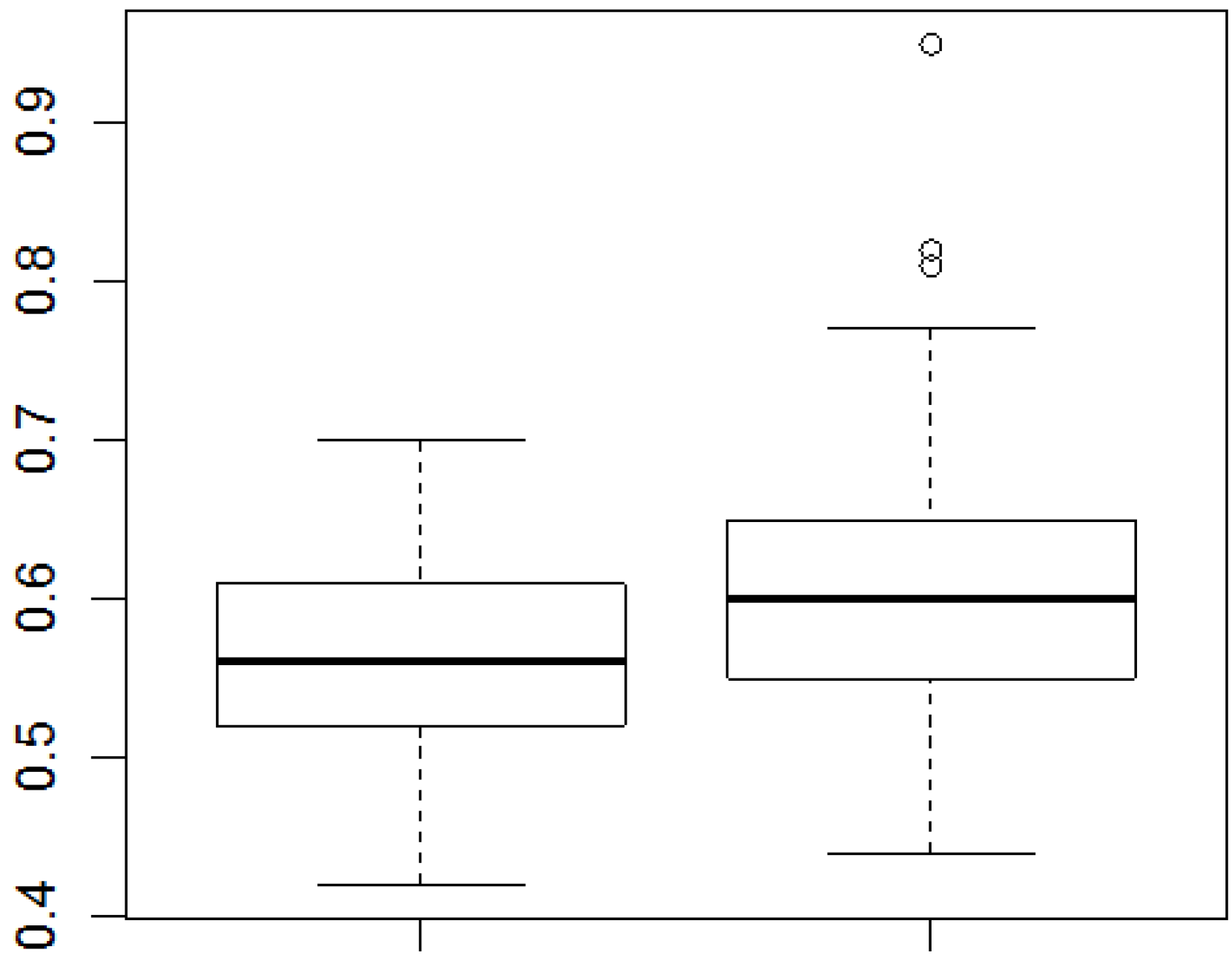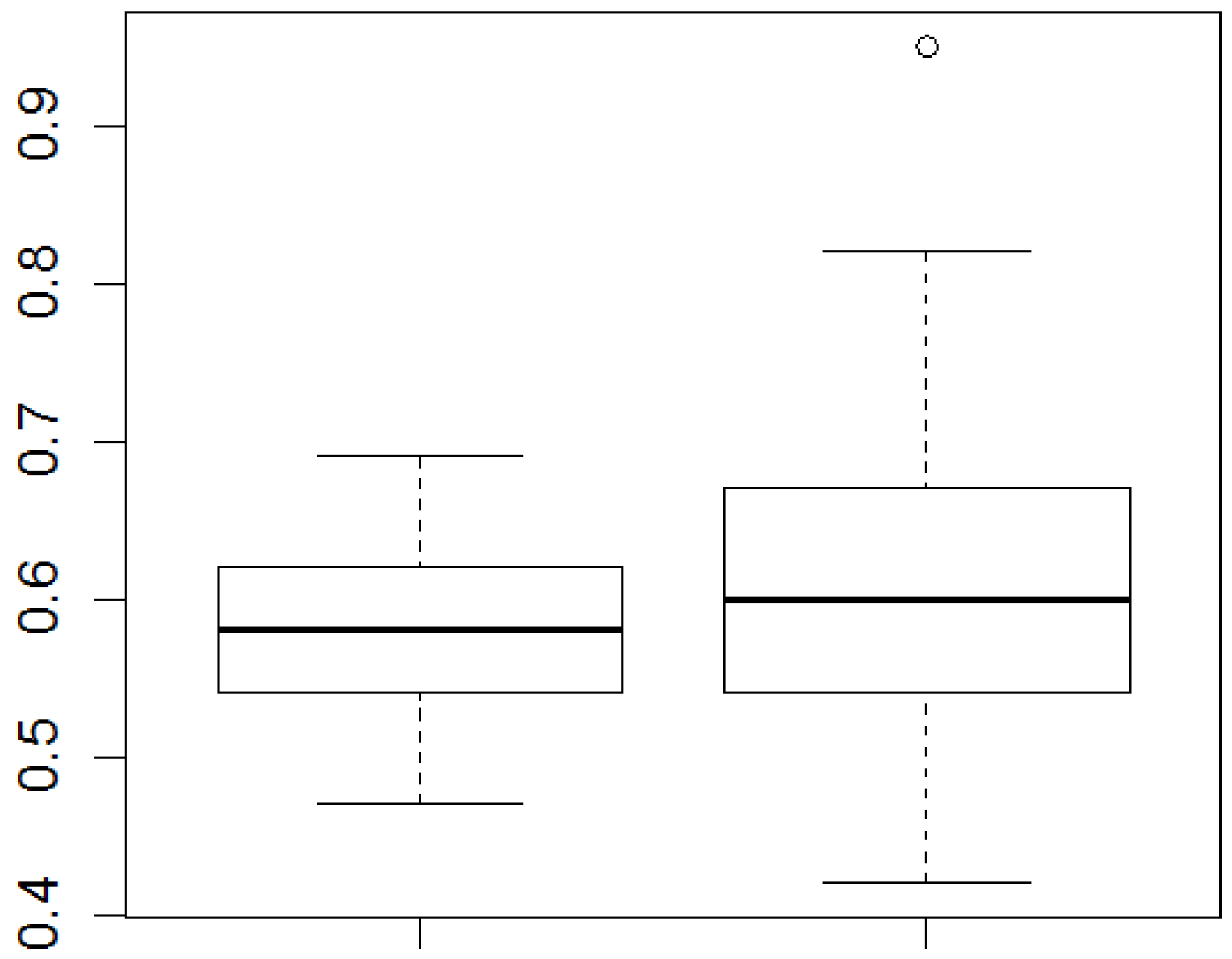Association Between Waist-to-Height Ratio, Isolated and Combined Morbidities and C-Reactive Protein in the Elderly: A Clinical-Epidemiological Study
Abstract
:1. Introduction
2. Experimental Section
2.1. Study Characterization
2.2. Sampling
2.3. Data Collection
2.4. Statistical Analysis
3. Results
| Characteristics | Mean | Median | SD | Range | N (%) |
|---|---|---|---|---|---|
| Demographic and socioeconomic description | |||||
| Gender | |||||
| Male | 52 (30.59) | ||||
| Female | 118 (69.41) | ||||
| Age (years) | 68.80 | 67.50 | 7.28 | 30.00 | |
| Family income (R$) | 2137.89 | 1200.00 | 2342.84 | 13,938.00 | |
| Educational level (years) | |||||
| 0 years | 13 (7.64) | ||||
| Up to 9 years | 99 (58.23) | ||||
| More than 9 years | 55 (32.35) | ||||
| Not provided | 3 (1.78) | ||||
| Anthropometric characteristics | |||||
| Weight (kg) | 66.61 | 65.00 | 13.23 | 78.20 | |
| Height (m) | 1.55 | 1.55 | 0.09 | 0.49 | |
| Waist (cm) | 92.92 | 92.50 | 11.61 | 72.30 | |
| BMI (kg/m²) ∞ | 27.51 | 26.84 | 4.74 | 27.27 | |
| Normal weight § | 22.84 | 57 (33.52) | |||
| Overweight § | 27.32 | 27.26 | 1.51 | 4.85 | 61 (35.88) |
| Obesity § | 33.21 | 32.19 | 3.28 | 13.45 | 51 (30.00) |
| WHtR | 0.60 | 0.59 | 0.08 | 0.53 | 170(100) |
| Morbidities | |||||
| None * | 49 (28.82) | ||||
| Hypertension * | 103 (58.52) | ||||
| Diabetes * | 26 (14.77) | ||||
| Overweight § | 60 (34.10) | ||||
| Obesity § | 51 (28.98) | ||||
| Lifestyle | |||||
| User of medications | 125 (71.02) | ||||
| User of anti-inflammatories | 15 (8.52) | ||||
| Biochemical data | |||||
| C-reactive protein (PCR) (mg/dL) | 2.83 | 1.60 | 3.20 | 19.19 |
| Correlation | r | p-value |
|---|---|---|
| WHtR – CRP | 0.16 | 0.0379 * |
| WHtR – Age | 0.12 | 0.1152 |
| CRP – Age | −0.05 | 0.5126 |


4. Discussion
5. Conclusions
Acknowledgments
Author Contributions
Conflicts of Interest
References
- Institute of Municipal Development and State of Paraíba (IDEME). IDEME Presents Study on the Elderly Population of Paraíba between 2000 and 2010. Available online: http://www.paraiba.pb.gov.br/57491/ideme-apresenta-estudo-sobre-a-populacao-idosa-da-paraiba-entre-2000-e-2010.html (accessed on 29 October 2013).
- Kearney, P.; Cronin, H; O’Regan, C.; Kamiya, Y.; Savva, G.; Whelan, B.; Kenny, R. Cohort profile: The Irish longitudinal study on ageing. Int. J. Epidemiol. 2011, 40, 877–884. [Google Scholar] [CrossRef]
- Demographic Evolution, 1950–2010; Brazilian Institute of Geography and Statistics: Rio de Janeiro, Brazil, 2010.
- Huerta, J.; Gonzáles, S.; Fernandéz, S.; Patterson, A.; Lasheras, C. Lipid peroxidation, antioxidant status and survival in institucionalised elderly: A five-years longitudinal study. Free Radical Res. 2006, 40, 571–578. [Google Scholar] [CrossRef]
- Keep Fit Far Life: Meeting the Nutritional Needs of Older Persons; World Health Organization (WHO): Geneva, Switzerland, 2002.
- Vlassopoulos, A.; Combet, E.; Lean, M.E. Changing distributions of body size and adiposity with age. Int. J. Obesity 2014, 38, 857–864. [Google Scholar] [CrossRef]
- Pinho, C.; Diniz, A.; Arruda, I.; Batista Filho, M.; Coelho, P.; Sequeira, L.; Lira, P. Prevalence of abdominal obesity and associated factors among individuals 25 to 59 years of age in Pernambuco State, Brazil. Cad. Saúde. Pública. 2013, 29, 313–324. [Google Scholar] [CrossRef]
- Deaton, C.; Froelicher, E.; Wuc, L.; Ho, C.; Shishani, K.; Jaarsma, T. The global burden of cardiovascular disease. Eur. J. Cardiovasc. Nurs. 2011, 10, 5–13. [Google Scholar]
- Li, W.; Chen, I.; Chang, Y.; Loke, S.; Wang, S.; Hsiao, K. Waist-to-height ratio, waist circumference, and body mass index as indices of cardiometabolic risk among 36.642 Taiwanese adults. Eur. J. Nutr. 2013, 52, 57–65. [Google Scholar] [CrossRef]
- Tatsumi, Y.; Watanabe, M.; Kokubo, Y.; Nishimura, K.; Higashiyama, A.; Okamura, T.; Okayama, A.; Miyamoto, Y. Effect of age on the association between waist-to-height ratio and incidence of cardiovascular disease: The Suita study. J. Epidemiol. 2013, 23, 351–359. [Google Scholar]
- Dong, X.; Liu, Y.; Yang, J.; Sun, Y.; Chen, L. Efficiency of anthropometric indicators of obesity for identifying cardiovascular risk factors in a Chinese population. Postgrad. Med. J. 2011, 87, 251–256. [Google Scholar] [CrossRef]
- Guasch-Ferré, M.; Bulló, M.; Martínez-González, M.; Corella, D.; Estruch, R.; Covas, M.; Arós, F.; Warnberg, J.; Fiol, M.; Lapetra, J.; Munõz, M.; Serra-Majem, L.; Pinto, X.; Babio, N.; Díaz-López, A.; Salas-Salvado, J. Waist-to-height ratio and cardiovascular risk factors in elderly individuals at high cardiovascular risk. PLoS One 2012, 7. [Google Scholar] [CrossRef]
- García-Bailo, B.; da Costa, L.; Arora, P.; Karmali, M.; El-Sohemy, A.; Badawi, A. Plasma vitamin D and biomarkers of cardiometabolic disease risk in adult Canadians, 2007–2009. Prev. Chronic Dis. 2013, 10. [Google Scholar] [CrossRef]
- Mcdade, T.; Rutherford, J.; Adair, L.; Kuzawa, C. Population differences in associations between C-reactive protein concentration and adiposity: Comparison of young adults in the Philippines and the United States. Amer. J. Clin. Nutr. 2009, 89, 1237–1245. [Google Scholar] [CrossRef]
- Phillips, C.; Perry, I. Does inflammation determine metabolic health status in obese and nonobese adults? J. Clin. Endocrinol. Metab. 2013, 98, 1–10. [Google Scholar] [CrossRef]
- Wu, S.; Li, J.; Li, Y.; Jin, C.; Wang, L.; Ruan, C.; Zhu, J.; Wang, N.; Zhang, Z.; Wang, Y.; Wang, J. The distribution and influential factors of serum high sensitivity C-reactive protein in general population. Zhonghua Nei Ke Za Zhi 2010, 49, 1010–1014. [Google Scholar]
- Correia, L.; Penalva, R.; Correia, H.; Ladeia, A.; Menezes, M.; Suzart, I.; Moreira, A.; Lima, J.; Galvão, B.; Guimarães, A. Determinants of C-reactive protein in individuals very low socioeconomic status. Arq. Bras. Cardiol. 2010, 94, 216–223. [Google Scholar] [CrossRef]
- Yang, T.; Chou, Y.C.; Chu, C.H.; Lin, S.H.; Hsieh, P.C.; Hsu, C.H.; Bai, C.H.; You, S.L.; Sun, C.A. Metabolic syndrome and C-reactive protein concentration as independent correlates of chronic kidney disease. Endocr. Res. 2014, 39, 94–98. [Google Scholar] [CrossRef]
- Heron, M. Deaths: Leading Causes for 2007. National Vital Statistics Reports; 26 August 2011. Available online: http://www.cdc.gov/nchs/data/nvsr/nvsr59/nvsr59_08.pdf (accessed on 11 September 2014). [Google Scholar]
- Ogden, C.L.; Margaret, D.; Caroll, M.S.P.H.; Brian, K.K.; Flegal, K.M. Prevalence of Obesity in the United States, 2009–2010. NCHS Data Brief; 2012. Available online: http://www.cdc.gov/nchs/data/databriefs/db82.pdf (accessed on 9 September 2014). [Google Scholar]
- Calder, P.C.; Ahluwalia, N.; Brouns, F.; Buetler, T.; Clement, K.; Cunningham, K.; Esposito, K.; Jönsson, L.S.; Kolb, H.; Lansink, M.; Marcos, A.; Margioris, A.; Matusheski, N.; Nordmann, H.; O’brien, J.; Pugliese, G.; Rizkalla, S.; Schalkwijk, C.; Tuomilehto, J.; Wärnberg, J.; Watzl, B.; Winklhofer-Roob, B.M. Dietary factors and low-grade inflammation in relation to overweight and obesity. Brit. J. Nutr. 2011, 106, 5–78. [Google Scholar] [CrossRef]
- R Development Team. R: A Language and Environment for Statistical Computing. R Foundation for Statistical Computing, 2009. Available online: http://www.r-project.org (accessed on 16 April 2010).
- Luna, R.; Nascimento, C.; Asciutti, L.; Franceschini, S.; Filizola, R.; Diniz, A.; Moraes, R.; Rivera, M.; Gonçalves, M.; Costa, M. Relation between glucose levels, high-sensitivity C-reactive protein (hs-CRP), body mass index (BMI) and serum and dietary retinol in elderly in population-based study. Arch. Gerontol. Geriatr. 2011, 54, 462–468. [Google Scholar]
- WHO Consultation on Obesity. In Obesity: Preventing and Managing the Global Epidemic; WHO: Geneva, Switzerland, 1997.
- Browning, L.; Hsieh, S.; Ashwel, M. A systematic review of waist-to-height ratio as a screening tool for the prediction of cardiovascular disease and diabetes: 0·5 could be a suitable global boundary value. Nutr. Res. Rev. 2010, 23, 247–269. [Google Scholar] [CrossRef]
- Herbeth, B.; Siest, G.; Henny, J. High-sensitivity C-reactive protein (CRP) reference intervals in the elderly. Clin. Chem. Lab. Med. 2001, 39, 1169–1170. [Google Scholar]
- Lino, V.; Portela, M.; Camacho, L.; Atie, S.; Lima, M. Assessment of social support and its association to depression, self-perceived health and chronic diseases in elderly individuals residing in an area of poverty and social vulnerability in Rio de Janeiro City, Brazil. PLos One 2013, 8. [Google Scholar] [CrossRef]
- Navaneethan, S.D.; Kirwan, J.P.; Arrigain, S.; Sehgal, A.; Schold, J. Overweight, obesity and international weight loss in chronic kidney disease: NHANES 1999–2006. Int. J. Obes. 2012, 36, 1585–1590. [Google Scholar] [CrossRef]
- American College of Sports Medicine. Available online: www.acsm.org/docs/fit-society-page/2011summerfspn_behaviorchange.pdf (accessed on 30 November 2012).
- Kuo, R.J.; Wu, Y.H.; Chen, L.K. Inability of waist-to-height ratio to predict new onset diabetes mellitus among older adults in Taiwan: A five-year observational cohort study. Arch. Gerontol. Geriatr. 2011, 53, 1–4. [Google Scholar] [CrossRef]
- Xu, Z.; Qi, X.; Dahl, A.; Xu, W. Waist-to-height ratio is the best indicator for undiagnosed Type 2 diabete. Diabet. Med. 2013, 30, 201–207. [Google Scholar] [CrossRef]
- Jayawardana, R.; Ranasinghe, P.; Sheriff, M.; Matthews, D.; Katulanda, P. Waist to height ratio: A better anthropometric marker of diabetes and cardio-metabolic risks in South Asian adults. Diabetes Res. Clin. Pract. 2013, 99, 292–299. [Google Scholar] [CrossRef]
- Veloso, H.; Silva, A. Prevalência e fatores associados à obesidade abdominal e ao excesso de peso em adultos maranhenses. Rev. Bras. Epidemiol. 2010, 13, 400–412. [Google Scholar]
- Ronsoni, R.; Coutinho, M.; Pereira, M.; Silva, R.; Becker, I.; Sehnen, L., Jr. Prevalence of obesity and its associated factors in the population of Tubarão-SC. Arq. Catarin Med. 2005, 34, 51–57. [Google Scholar]
- Palacios, C.; Pérez, C.; Guzmán, M.; Ortiz, A.; Ayala, A.; Suárez, E. Association between adiposity indices and cardiometabolic risk factors among adults living in Puerto Rico. Public Health Nutr. 2011, 14, 1714–1723. [Google Scholar]
© 2014 by the authors; licensee MDPI, Basel, Switzerland. This article is an open access article distributed under the terms and conditions of the Creative Commons Attribution license (http://creativecommons.org/licenses/by/3.0/).
Share and Cite
Silva, J.P.d.; Lima, R.P.A.; De Carvalho Pereira, D.; De Oliveira Silva, C.S.; Gonçalves, M.D.C.R.; Filho, M.B.; Filizola, R.G.; De Moraes, R.M.; Asciutti, L.S.R.; De Carvalho Costa, M.J. Association Between Waist-to-Height Ratio, Isolated and Combined Morbidities and C-Reactive Protein in the Elderly: A Clinical-Epidemiological Study. Int. J. Environ. Res. Public Health 2014, 11, 9595-9606. https://doi.org/10.3390/ijerph110909595
Silva JPd, Lima RPA, De Carvalho Pereira D, De Oliveira Silva CS, Gonçalves MDCR, Filho MB, Filizola RG, De Moraes RM, Asciutti LSR, De Carvalho Costa MJ. Association Between Waist-to-Height Ratio, Isolated and Combined Morbidities and C-Reactive Protein in the Elderly: A Clinical-Epidemiological Study. International Journal of Environmental Research and Public Health. 2014; 11(9):9595-9606. https://doi.org/10.3390/ijerph110909595
Chicago/Turabian StyleSilva, Jousianny Patrício da, Raquel Patrícia Ataíde Lima, Danielle De Carvalho Pereira, Cassia Surama De Oliveira Silva, Maria Da Conceiço Rodrigues Gonçalves, Malaquias Batista Filho, Rosália Gouveia Filizola, Ronei Marcos De Moraes, Luiza Sonia Rios Asciutti, and Maria José De Carvalho Costa. 2014. "Association Between Waist-to-Height Ratio, Isolated and Combined Morbidities and C-Reactive Protein in the Elderly: A Clinical-Epidemiological Study" International Journal of Environmental Research and Public Health 11, no. 9: 9595-9606. https://doi.org/10.3390/ijerph110909595
APA StyleSilva, J. P. d., Lima, R. P. A., De Carvalho Pereira, D., De Oliveira Silva, C. S., Gonçalves, M. D. C. R., Filho, M. B., Filizola, R. G., De Moraes, R. M., Asciutti, L. S. R., & De Carvalho Costa, M. J. (2014). Association Between Waist-to-Height Ratio, Isolated and Combined Morbidities and C-Reactive Protein in the Elderly: A Clinical-Epidemiological Study. International Journal of Environmental Research and Public Health, 11(9), 9595-9606. https://doi.org/10.3390/ijerph110909595




